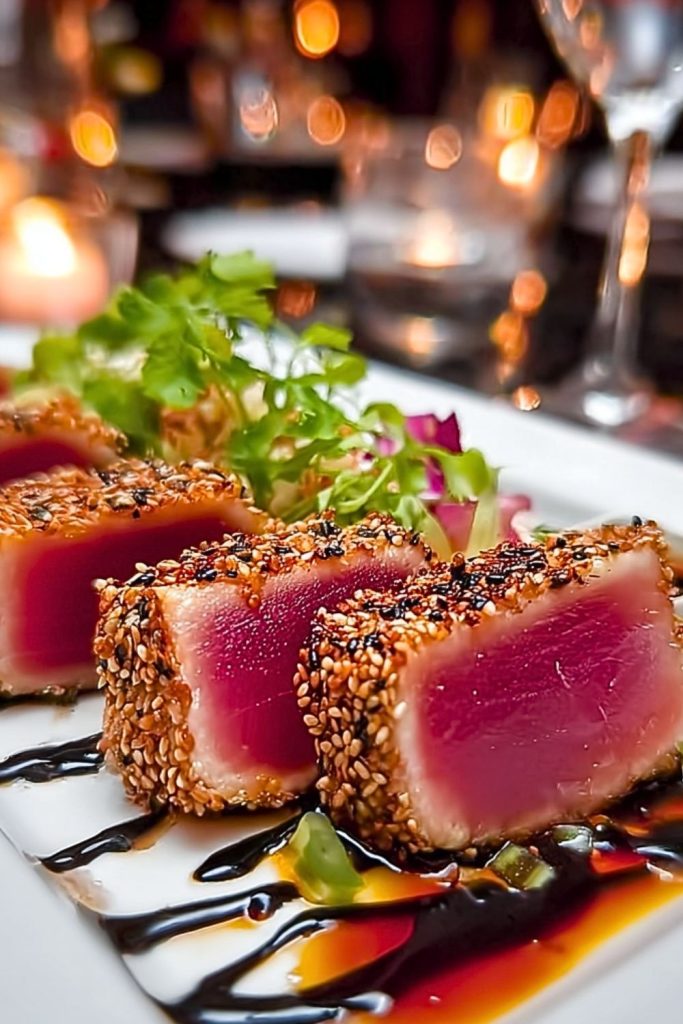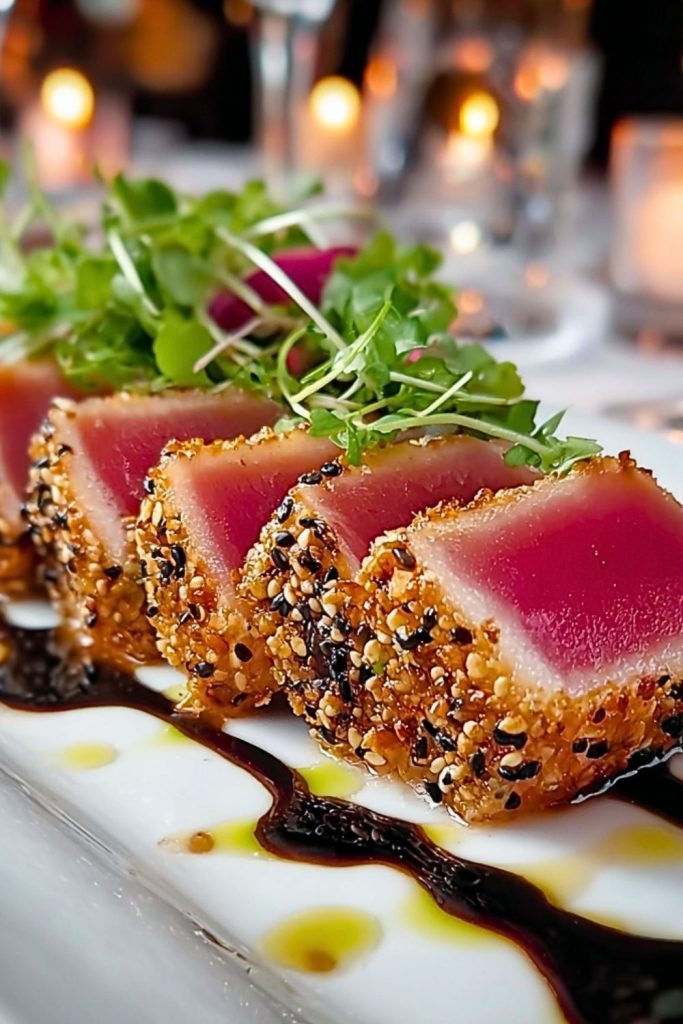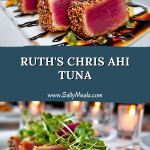When it comes to dining at Ruth’s Chris Steakhouse, their Ahi Tuna is one dish that stands out and leaves a lasting impression. This dish is a perfect combination of the freshest tuna, lightly seared on the outside while maintaining its raw, tender texture inside, and finished with a sesame seed crust for that extra crunch. Paired with a delicious drizzle of balsamic glaze and fresh greens, it’s the epitome of a perfect balance of flavors. If you’re a fan of seafood and looking to recreate this gourmet treat at home, you’re in for a real treat. I was fortunate enough to learn the art of making this dish, and I can’t wait to share the secrets with you!

This Ahi Tuna recipe offers a restaurant-quality experience without needing to step out of your kitchen. Whether you’re hosting a dinner party or preparing a special meal for yourself, this dish is guaranteed to impress. Plus, it’s incredibly quick and easy to prepare, so you won’t be spending hours in the kitchen. Let’s dive into the details of how you can make your very own Ruth’s Chris Ahi Tuna at home!
Why You’ll Love This Ahi Tuna
This Ahi Tuna recipe is packed with flavors and textures that are sure to excite your taste buds. The combination of the tender raw tuna and the crispy sesame seed crust provides an irresistible contrast that is both satisfying and refined. The addition of balsamic glaze adds a rich sweetness that perfectly complements the natural flavors of the tuna. This dish is not only a feast for the palate but also a visual masterpiece. Whether you’re a sushi lover or simply someone who appreciates a good seared fish, this Ahi Tuna will elevate your culinary repertoire.
Additionally, the health benefits of Ahi Tuna make it an even more appealing option. Rich in omega-3 fatty acids, high-quality protein, and essential vitamins, it’s a dish that feels indulgent yet nutritious. It’s also a great choice for those following a low-carb or keto diet, as it’s packed with lean protein and minimal carbohydrates. You’ll find yourself making this recipe over and over again!
What Kind of Ahi Tuna Should I Use?
When selecting Ahi Tuna for this recipe, it’s essential to go for the freshest and highest quality tuna available. If possible, seek out sushi-grade tuna from your local fish market or grocery store. Sushi-grade tuna is a term used for fish that is considered safe to eat raw due to its freshness and quality. Fresh tuna will have a bright, vibrant pink color and a firm texture. If you’re unsure, ask your fishmonger for recommendations, as they will be able to guide you on the best cuts for searing.
If fresh tuna isn’t available, frozen tuna can be a suitable alternative. Be sure to thaw it completely in the fridge before using it to avoid compromising its texture and flavor.
Options for Substitutions
While Ahi Tuna is the star of the show, you can experiment with different ingredients to cater to your preferences or dietary needs. Here are a few options:
- Tuna Alternative: If you’re not a fan of tuna, you can substitute it with other fish like salmon or even swordfish. These options will provide a similar texture and can be seared in the same way.
- Sesame Crust: If you don’t have sesame seeds, you can use panko breadcrumbs for a crispy coating, or even crushed nuts like almonds or pistachios for a different flavor.
- Balsamic Glaze Substitute: If balsamic glaze isn’t available, you can easily make your own by reducing balsamic vinegar with a bit of honey or sugar until it thickens, or try a different glaze such as teriyaki for a different spin on the flavor.
Ingredients for This Ahi Tuna Recipe
Each ingredient in this Ahi Tuna recipe plays a crucial role in building layers of flavor, texture, and presentation. Here’s what you’ll need and why it’s essential:
- Sushi-Grade Ahi Tuna Steaks – The star of the dish. You want thick, center-cut pieces that can handle a quick sear while remaining raw and tender in the center.
- Sesame Seeds (White and Black) – These add a nutty crunch and stunning visual appeal. The mix of both seeds gives a lovely contrast to the lightly seared exterior.
- Soy Sauce – Provides umami and saltiness, used both in the marinade and for dipping.
- Fresh Ginger – Brings warmth and a hint of spice to complement the rich tuna.
- Garlic (minced) – Adds depth to the marinade with its bold, aromatic profile.
- Sesame Oil – Used in the marinade to enhance the nutty notes and tie the dish together.
- Wasabi Paste (optional) – A sharp kick of heat for those who love that classic sushi-bar zing.
- Balsamic Glaze – A slightly sweet and tangy drizzle that enhances the overall flavor profile.
- Mixed Greens or Microgreens – These fresh elements balance out the richness of the tuna and make the dish feel light and refreshing.
- Olive Oil (for searing) – A neutral base to get a beautiful crust without overpowering the flavor of the fish.

Step 1: Prepare the Tuna
Start by patting the tuna steaks dry with paper towels. This helps the sesame seeds adhere better and ensures a good sear. If the steaks are uneven in thickness, you can gently press them to make sure they cook evenly. Lightly season the tuna with a pinch of salt.
Step 2: Marinate Briefly
In a shallow dish, whisk together soy sauce, minced garlic, freshly grated ginger, and sesame oil. Place the tuna steaks into the marinade, turning to coat all sides. Let them sit for 10–15 minutes at room temperature. Avoid over-marinating—this is just to infuse light flavor, not to cure the fish.
Step 3: Coat with Sesame Seeds
On a flat plate, mix the white and black sesame seeds evenly. Remove the tuna from the marinade and press each steak firmly into the sesame seed mix on all sides to create a solid crust. Gently pat the seeds into the fish to help them stick.
Step 4: Sear the Tuna
Heat olive oil in a non-stick or cast iron skillet over medium-high heat until shimmering. Carefully place the tuna steaks in the pan. Sear for about 45 seconds to 1 minute per side—just enough to toast the sesame seeds and form a crust while keeping the center rare.
Step 5: Slice and Plate
Transfer the seared tuna to a cutting board and let it rest for a minute. Using a sharp knife, slice into ½-inch thick pieces. Arrange on a plate over mixed greens or microgreens, and drizzle with balsamic glaze. Add a touch of wasabi on the side if desired.
How Long to Cook the Ahi Tuna
Cooking Ahi Tuna is all about precision and restraint. Since the goal is a beautifully rare center with a flavorful seared crust, the cooking time is very short. Sear each side for about 45 seconds to 1 minute on a hot skillet over medium-high heat. You’re not cooking it through — you’re just forming a crust on the outside while leaving the inside cool and pink.
If you prefer your tuna a little more done (closer to medium-rare), you can increase the searing time slightly to 1.5 minutes per side, but be careful not to overcook it or the texture will become dry and grainy instead of silky and smooth.
Tips for Perfect Ahi Tuna
- Start with high-quality, sushi-grade tuna – This is the most important step for safety and flavor since most of the tuna remains raw.
- Pat the tuna dry before searing. Moisture prevents a good crust from forming and may cause the sesame seeds to steam instead of toast.
- Use a very hot pan – A cast iron or heavy-bottomed skillet gives the best sear in the shortest time.
- Don’t over-marinate – 10 to 15 minutes is plenty. Longer and the acids in soy or citrus may start to “cook” the fish.
- Slice with a sharp knife – Ahi Tuna is delicate, so use a clean, sharp blade to get those perfect sashimi-style cuts.
- Press the sesame crust firmly into the tuna so it adheres well and doesn’t fall off in the pan.
- Let the tuna rest briefly after searing to allow juices to settle before slicing.
Watch Out for These Mistakes While Cooking
Even though this Ahi Tuna recipe is simple and quick, a few common mistakes can compromise its quality. Here’s what to keep an eye on:
- Overcooking the Tuna – The biggest pitfall. Tuna should be seared quickly at high heat. More than 1–1.5 minutes per side and you’ll lose that luxurious, sashimi-like center.
- Using Low-Quality Tuna – This dish depends on fresh, sushi-grade fish. If you use standard supermarket cuts meant for cooking through, the flavor and texture won’t hold up.
- Skipping the Dry Pat – Moisture is the enemy of a good sear. Always pat the tuna completely dry before applying sesame seeds.
- Not Pressing the Crust – A loose crust will fall off in the pan. Press sesame seeds firmly into the tuna for a solid, even coating.
- Cooking in a Cold Pan – If the skillet isn’t properly heated, you won’t get that beautiful crust, and the sesame seeds may burn before the tuna sears.
- Overloading the Pan – Sear one or two steaks at a time to keep the heat high and the crust crispy. Crowding the pan causes steaming.
What to Serve With Ahi Tuna?
Pairing the right sides with your Ahi Tuna enhances the overall experience. Here are a few flavorful, well-balanced suggestions:
Citrus Ponzu Dipping Sauce
A zesty, soy-based dip with citrus juice adds brightness and a subtle tang that pairs beautifully with the savory tuna.
Seaweed Salad
Its delicate texture and umami profile complement the tuna perfectly, while adding a refreshing crunch.
Steamed Jasmine Rice or Sushi Rice
A lightly seasoned, warm rice base gives the dish substance and soaks up all the juices and glaze.
Pickled Ginger
Cleanses the palate between bites and echoes the sushi-style flair of the dish.
Cucumber Avocado Salad
A cooling, creamy side that adds contrast and balances the saltiness of the soy and sesame crust.
Garlic Edamame
Sautéed edamame with garlic and sea salt adds a touch of warmth and a satisfying snack-like element to the plate.
Chilled Soba Noodles
Light and refreshing, soba noodles can be tossed with sesame oil and scallions for a simple but sophisticated side.
Crispy Wonton Chips
Serve alongside the tuna for scooping, crunching, or just for an extra layer of texture.
Storage Instructions
Ahi Tuna is best enjoyed fresh, right after it’s cooked and sliced. However, if you have leftovers, they can be stored safely:
- Refrigerator: Place the leftover tuna in an airtight container and store it in the fridge for up to 24 hours. Since it’s only lightly seared and mostly raw, the quality and safety diminish after a day.
- Sliced vs. Whole: If possible, store the tuna unsliced. Whole pieces hold moisture and texture better. Re-slice just before serving.
- Reheating: Avoid reheating, as it will overcook the tuna and ruin the texture. Instead, serve leftovers cold, like a tuna tataki salad or in a rice bowl.
- Do Not Freeze: Freezing cooked/seared Ahi Tuna ruins its delicate texture and flavor. Only freeze raw tuna steaks before searing, if necessary.
Estimated Nutrition
These nutrition facts are based on a single 6-ounce Ahi Tuna steak, lightly seared with sesame seeds and served with balsamic glaze and greens.
- Calories: ~310 kcal
- Protein: 38g
- Total Fat: 15g
- Saturated Fat: 2g
- Unsaturated Fat: 11g
- Trans Fat: 0g
- Cholesterol: 50mg
- Carbohydrates: 6g
- Fiber: 1g
- Sugar: 3g
- Sodium: 520mg
- Serving Size: 1 steak (about 6 oz)
Keep in mind, these numbers may vary slightly depending on how much glaze or oil you use, and if any additional sides are added.
Frequently Asked Questions
How do I know if my Ahi Tuna is sushi-grade?
Look for tuna labeled “sushi-grade” or “sashimi-grade” at a trusted fish market or grocery store. It should have a vibrant pink-red color, no strong odor, and a firm texture. Always ask the fishmonger if it’s safe to eat raw.
Can I use frozen Ahi Tuna for this recipe?
Yes, as long as it’s sushi-grade and properly frozen. Thaw it slowly in the refrigerator before cooking. Avoid defrosting at room temperature to maintain texture and safety.
Do I need to marinate the tuna?
Marinating is optional but recommended for a flavor boost. Just 10–15 minutes is enough to enhance the taste without affecting the texture.
Can I make this dish in advance?
It’s best served fresh, but you can sear the tuna a few hours ahead, chill it, and slice it right before serving for a chilled version. Great for entertaining!
What if I don’t like rare tuna?
You can sear the tuna longer for a more cooked center, but keep in mind, it changes the silky texture. Try 1.5–2 minutes per side for medium.
What’s a good dipping sauce alternative?
Besides soy sauce or ponzu, try wasabi mayo, spicy aioli, or a ginger-scallion vinaigrette for different flavor profiles.
Is Ahi Tuna healthy?
Yes! It’s rich in lean protein and omega-3 fatty acids, low in carbs, and provides essential nutrients like B12, selenium, and niacin.
What can I do with leftover Ahi Tuna?
Use it in a poke bowl, sliced over a salad, in a tuna wrap, or tossed into chilled soba noodles. Just serve cold—don’t reheat.
Conclusion
Ruth’s Chris Ahi Tuna is more than just a pretty plate — it’s a bold, elegant, and surprisingly easy recipe that brings steakhouse quality right into your home kitchen. With its sesame-crusted sear, silky interior, and rich drizzle of balsamic glaze, this dish is perfect for a fancy dinner or a light, refreshing meal.
The key is quality ingredients and a hot pan — that’s it. Whether you’re a seafood lover or just exploring something new, this recipe is guaranteed to impress. Once you’ve mastered it, you might just find yourself making it again and again.

Ruth’s Chris Ahi Tuna
- Prep Time: 10 minutes
- Cook Time: 5 minutes
- Total Time: 15 minutes
- Yield: 2 servings 1x
- Category: Main Course
- Method: Seared
- Cuisine: American
Description
This Ruth’s Chris Ahi Tuna recipe delivers everything you love about the restaurant classic—fresh, sushi-grade tuna quickly seared with a sesame seed crust, then drizzled with a rich balsamic glaze and served over crisp greens. It’s elegant, flavorful, and surprisingly easy to make at home in under 20 minutes.
Ingredients
2 Sushi-grade Ahi Tuna Steaks (about 6 oz each)
3 tablespoons White Sesame Seeds
2 tablespoons Black Sesame Seeds
3 tablespoons Soy Sauce
1 teaspoon Fresh Ginger (grated)
1 clove Garlic (minced)
1 teaspoon Sesame Oil
1 teaspoon Wasabi Paste (optional)
2 tablespoons Balsamic Glaze
1 cup Mixed Greens or Microgreens
1 tablespoon Olive Oil (for searing)
Instructions
1. Pat tuna steaks dry and lightly season with salt.
2. In a shallow dish, mix soy sauce, garlic, ginger, and sesame oil. Marinate tuna for 10–15 minutes.
3. Combine sesame seeds on a plate. Press tuna into seeds to coat all sides.
4. Heat olive oil in a skillet over medium-high heat.
5. Sear each side of the tuna for 45 seconds to 1 minute.
6. Let rest briefly, then slice into 1/2-inch pieces.
7. Arrange over mixed greens and drizzle with balsamic glaze.
8. Serve with wasabi paste if desired.
Notes
Nutrition (per serving):
Calories: 310 kcal
Protein: 38g
Total Fat: 15g
– Saturated Fat: 2g
– Unsaturated Fat: 11g
– Trans Fat: 0g
Cholesterol: 50mg
Carbohydrates: 6g
– Fiber: 1g
– Sugar: 3g
Sodium: 520mg
Serving Size: 1 tuna steak (about 6 oz)
Nutrition
- Serving Size: 1 tuna steak (about 6 oz)
- Calories: 310
- Sugar: 3
- Sodium: 520
- Fat: 15
- Saturated Fat: 2
- Unsaturated Fat: 11
- Trans Fat: 0
- Carbohydrates: 6
- Fiber: 1
- Protein: 38
- Cholesterol: 50

